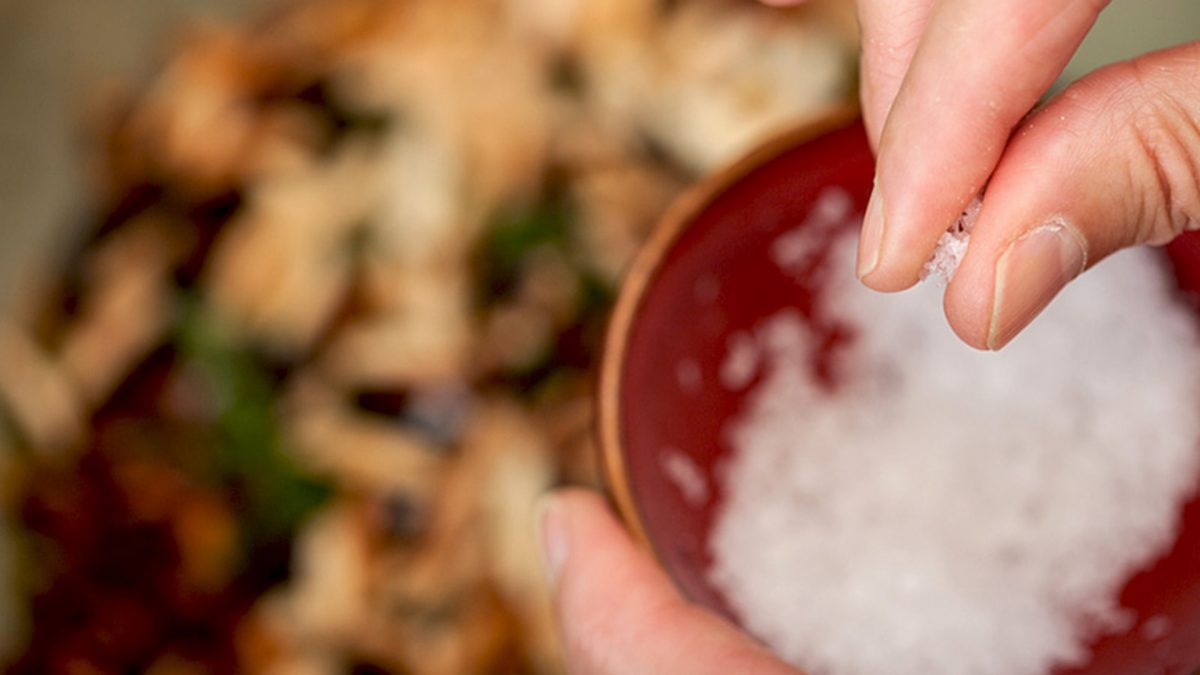As I discuss in my video Shaking the Salt Habit, the two most prominent dietary risks for death and disability in the world are not eating enough fruit and eating too much salt. Eating too little fruit kills nearly five million people every year, and eating too much salt kills four million.
There are three things we can do to lower our salt intake. First, don’t add salt at the table. One third of us add salt to our food before even tasting it! Second, stop adding salt while you’re cooking. At first, the food may taste bland, but within two to four weeks, “as the sensitivity of the salt taste receptors in the mouth become more sensitive to the taste of salt in the usual concentrations”—believe it or not—you may actually prefer the taste of food with less salt. Some of the flavorings you can use in the meanwhile instead of salt include “pepper, onion, garlic, tomato, sweet pepper, basil, parsley, thyme, celery, lime, chilli, nettle, rosemary, smoke flavoring, curry, coriander and lemon.” Even if you did add salt while cooking, though, it’s probably better than eating out, where even at non-fast food restaurants, they tend to pile it on. And, finally, avoid processed foods that have salt added.
In most countries, only about half of sodium intake comes from processed foods, so there’s more personal responsibility. In the United States, however, even if we completely stopped adding salt in the kitchen and dining room, it would only bring down salt intake a small fraction. This has led public health commentators to note how challenging it is for everyone to reduce their salt intake, since so much of our sodium intake is out of our control. But is it? We don’t have to buy all those processed foods. We can choose not to turn over our family’s health to food corporations that may not have our best interests at heart.
If we do buy processed foods, there are two tricks we can use. First, try to only buy foods with fewer milligrams of sodium listed on the label than there are grams in the serving size. So, if it’s a 100-gram serving size, it should have less than 100 mg of sodium. Or, second, shoot for fewer milligrams of sodium than there are calories. For example, if the sodium is listed as 720 and calories are 260, since 720 is greater than 260, the product has too much sodium.
That’s a trick I learned from Jeff Novick, one of my favorite dieticians of all time. The reason it works is that most people get about 2,200 calories a day. So, if everything you ate had more calories than sodium, you’d at least get under 2,300 milligrams of sodium, which is the upper limit for healthy people under age 50. Of course, the healthiest foods have no labels at all. We should try to buy as much fresh food as possible because it is almost impossible to come up with a diet consisting of unprocessed natural foodstuffs that exceeds the strict American Heart Association guidelines for sodium reduction.
Not eating enough fruit as a leading killer? For more, see my video Inhibiting Platelet Aggregation with Berries.
In my latest sodium series, I lay out the evidence and dive into the manufactured controversy to expose salt industry shenanigans. See:
- High Blood Pressure May Be a Choice
- Sprinkling Doubt: Taking Sodium Skeptics with a Pinch of Salt
- The Evidence That Salt Raises Blood Pressure
- Sodium Skeptics Try to Shake Up the Salt Debate
- Sodium and Arterial Function: A-Salting Our Endothelium
- Sodium and Autoimmune Disease: Rubbing Salt in the Wound?
- Salt of the Earth: Sodium and Plant-Based Diets
In health,
Michael Greger, M.D.
PS: If you haven’t yet, you can subscribe to my free videos here and watch my live, year-in-review presentations:
- 2012: Uprooting the Leading Causes of Death
- 2013: More Than an Apple a Day
- 2014: From Table to Able: Combating Disabling Diseases with Food
- 2015: Food as Medicine: Preventing and Treating the Most Dreaded Diseases with Diet
- 2016: How Not To Die: The Role of Diet in Preventing, Arresting, and Reversing Our Top 15 Killers
